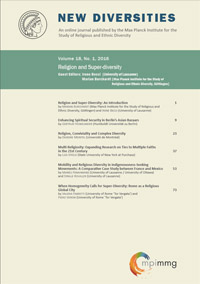Multi-Religiosity: Expanding Research on Ties to Multiple Faiths in the 21st Century
by Liza G. Steele (State University of New York at Purchase)
To cite this article: Steele, L. G. (2016). Multi-Religiosity: Expanding Research on Ties to Multiple Faiths in the 21st Century. New Diversities, 18(1), 37–52. https://doi.org/10.58002/6mrg-0n64
In the 21st century, it is not uncommon to encounter people with ties to more than one religion. Some examples of such multiple or dual religious ties (referred to as “multi-religiosity” for the purposes of this paper) include the practice of Buddhism among Christians and Jews, regular church attendance among those who say they are not religious, and the children of mixed religious couples who might be raised with some level of identification with the spiritual traditions of both parents. Yet, literature and data on the topic of multi-religiosity is scarce. Through an analysis of qualitative data gathered by the author in Brazil in 2007–2008 and data from a poll conducted by the Pew Research Center’s Forum on Religion and Public Life in the United States in 2009, this paper aims to draw attention to the prevalence of dual or multiple religious ties in 21st-century Western countries, and to encourage a reconsideration of traditional concepts and categories in scholarly approaches to studying religion.
Keywords: multi-religiosity, religious pluralism, dual religious belonging, religious superdiversity, sociology of religion
|
